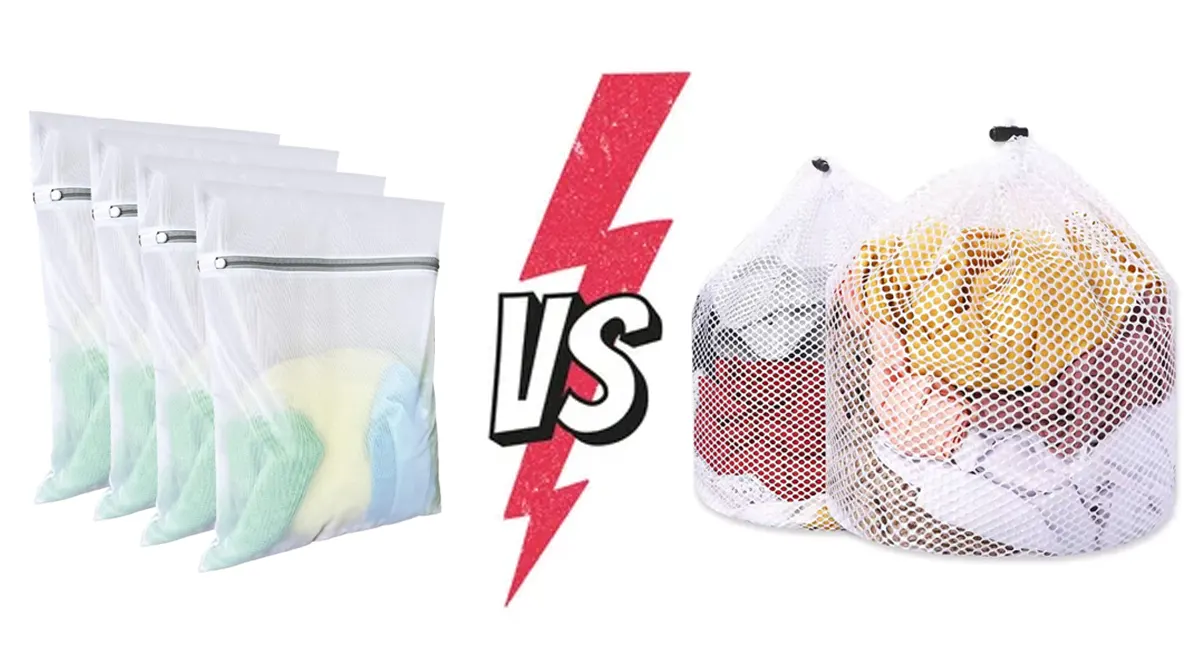Shopping bags are everywhere. You see them in grocery stores, boutiques, farmer’s markets, malls, and even at airports. They come in all shapes, styles, and materials. But one of the most overlooked aspects is size. The right shopping bag size makes your daily life easier, more comfortable, and more sustainable.
Think about it. If your bag is too small, you will struggle to fit your groceries and end up carrying multiple bags. If it is too big, it becomes awkward, heavy, and takes up too much space. That is why choosing the right shopping bag size matters not only for convenience, but also for durability and eco-friendly use.
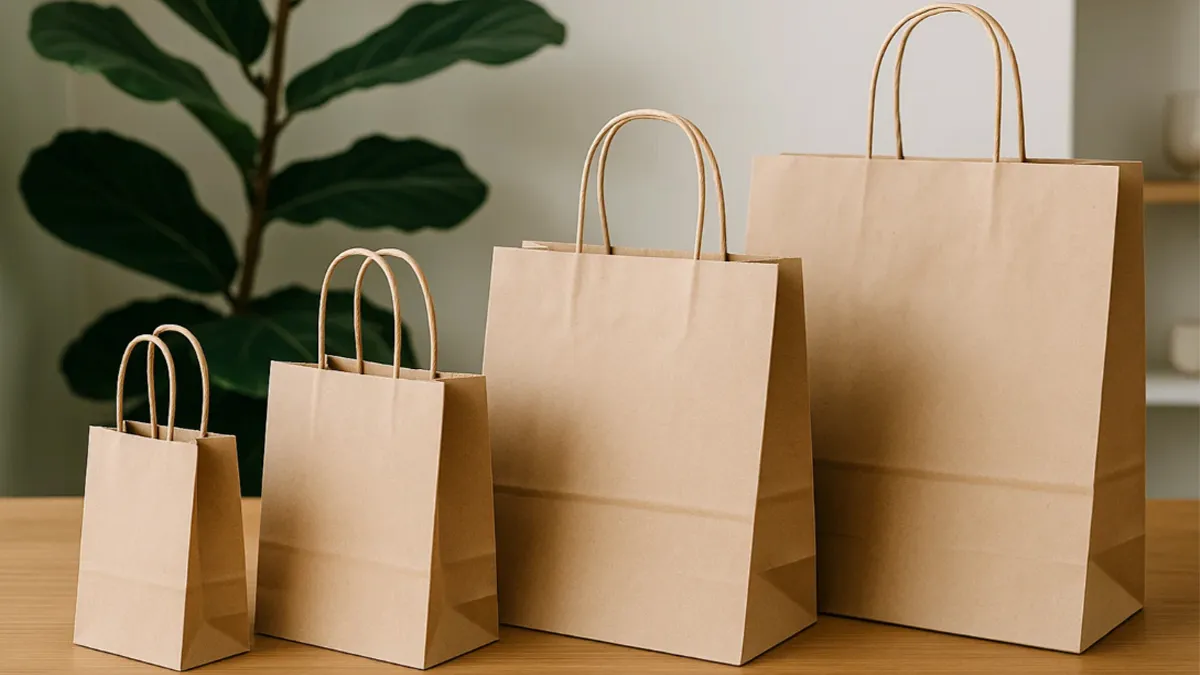
In this guide, we will walk you through everything you need to know about shopping bag sizes. We will compare standard dimensions, explore which sizes work best for different occasions, and give you practical tips for storage, materials, and even custom branding.
Why Shopping Bag Size Matters
It might seem like size is just a detail, but it actually has a big impact on how functional a shopping bag is.
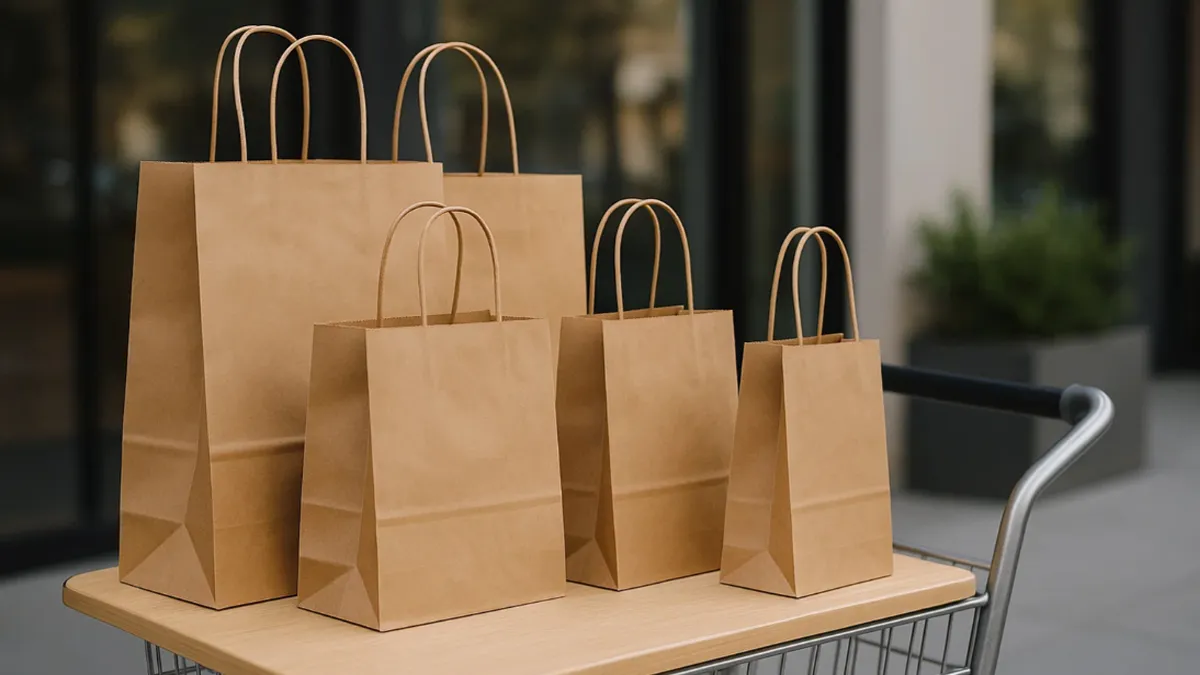
- Carrying capacity: A bag’s size directly affects how much you can carry. Too small and you make multiple trips. Too big and you may overload it.
- Comfort: Handle length, bag width, and depth all decide how easy it is to carry on your shoulder or by hand.
- Durability: If you stuff a small bag with too many items, it wears out quickly. A properly sized bag distributes weight better and lasts longer.
- Sustainability: A good-size bag gets used more often. Bags that are impractical in size sit unused at home, which defeats their eco purpose.
- Versatility: The right size can double as a grocery bag, travel tote, or even storage bag.
In short, size is not just about numbers; it is about how well the bag fits your lifestyle.
Standard Shopping Bag Sizes and Their Uses
Different retailers and manufacturers classify shopping bags into a few general categories: small, medium, large, and extra large. Let us break it down.
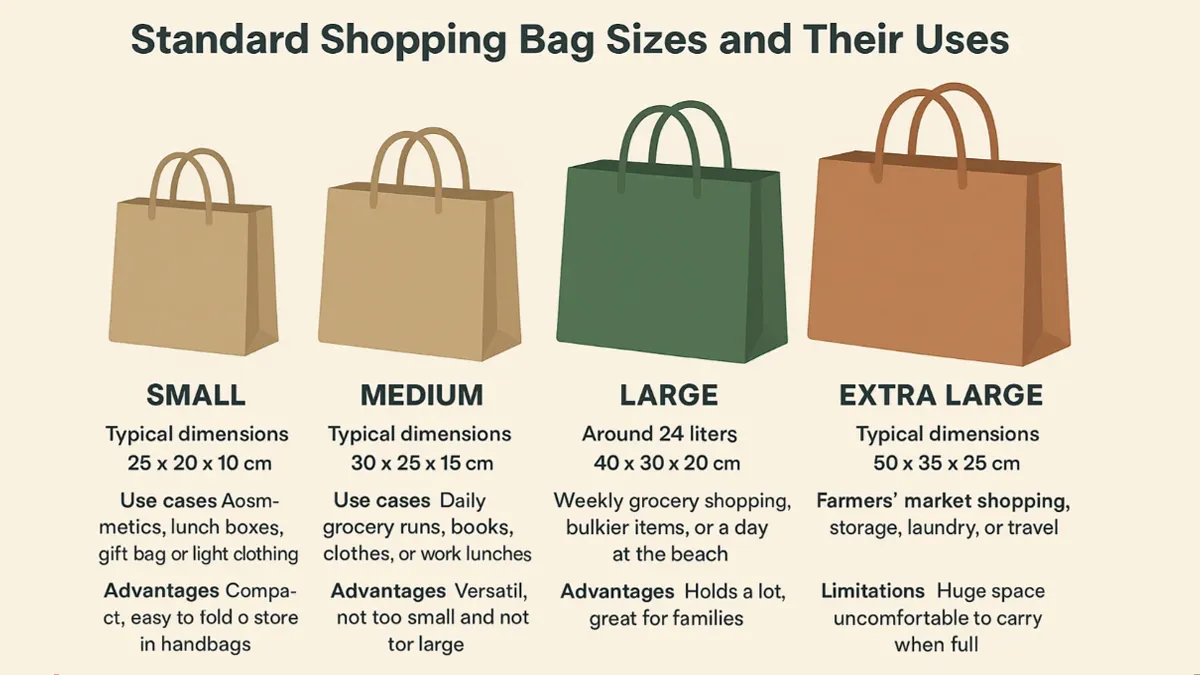
Small Size Bags
- Typical dimensions: 25 × 20 × 10 cm
- Capacity: Around 5 liters
- Use cases: Cosmetics, lunch boxes, gift bags, or light clothing items.
- Advantages: Compact, easy to fold and store in handbags.
- Limitations: Cannot handle bulky groceries or heavy items.
Medium Size Bags
- Typical dimensions: 30 × 25 × 15 cm
- Capacity: Around 12 liters
- Use cases: Daily grocery runs, books, clothes, or work lunches.
- Advantages: Versatile, not too small and not too large.
- Limitations: May not fit large grocery items or boxes.
Large Size Bags
- Typical dimensions: 40 × 30 × 20 cm
- Capacity: Around 24 liters
- Use cases: Weekly grocery shopping, bulkier items, or a day at the beach.
- Advantages: Holds a lot, great for families.
- Limitations: Heavy when full, harder to fold and store.
Extra Large Bags
- Typical dimensions: 50 × 35 × 25 cm
- Capacity: Around 40–45 liters
- Use cases: Farmers’ market shopping, storage, laundry, or travel.
- Advantages: Huge space, useful for irregularly shaped items.
- Limitations: Can be bulky and uncomfortable to carry when full.
Table 1: Shopping Bag Size Comparison
| Size | Dimensions (cm) | Approx Capacity | Best Uses | Notes |
|---|---|---|---|---|
| Small | 25 × 20 × 10 | ~5 L | Lunch, gifts, cosmetics | Handy, compact |
| Medium | 30 × 25 × 15 | ~12 L | Daily groceries, books, clothes | Balanced, versatile |
| Large | 40 × 30 × 20 | ~24 L | Weekly shopping, beach, books | Can get heavy when full |
| Extra Large | 50 × 35 × 25 | ~44 L | Markets, travel, storage | May be bulky |
Matching Bag Size with Different Occasions
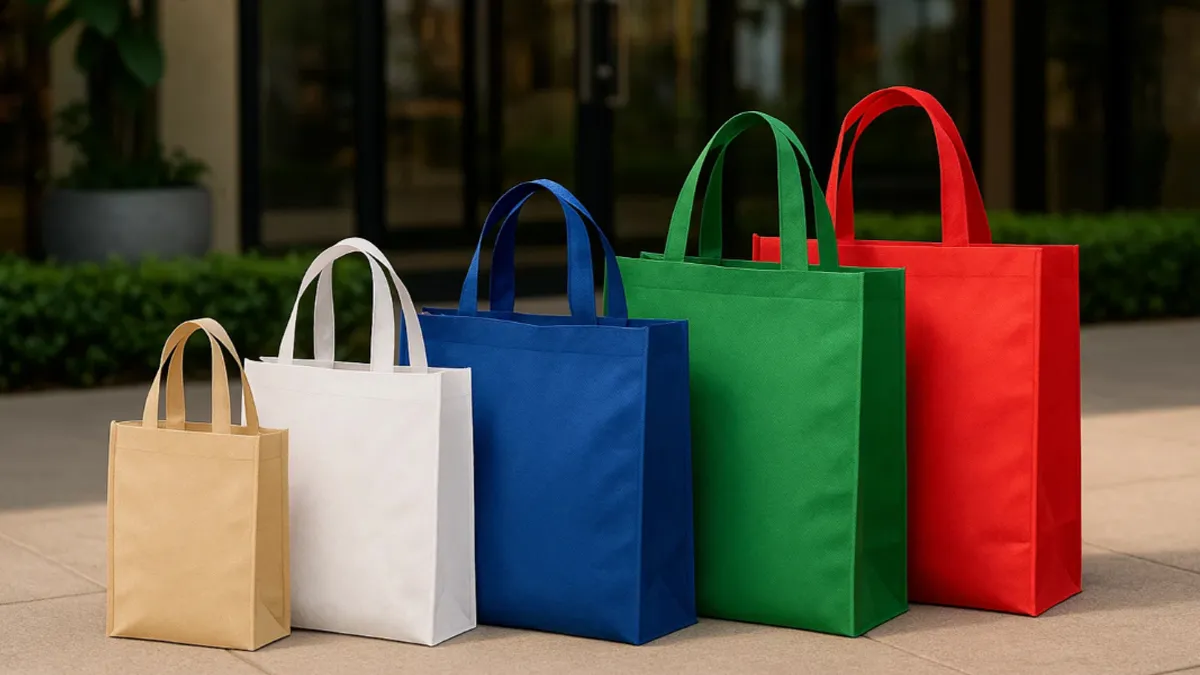
Grocery Shopping
For groceries, medium to large bags are the most practical. A medium bag handles daily trips, while a large one works for weekly shopping. If you often buy heavy items like milk, opt for two medium bags rather than one huge bag for balance.
Clothing or Gift Packaging
Stores usually use medium bags for clothing. For gifts, small bags are common for jewelry or cosmetics, while medium bags suit shoes or jackets.
Farmer’s Market
Extra large bags are ideal for irregular items like vegetables, bread, or flowers. The wide opening and deep capacity make packing easier.
Travel and Storage
Foldable nylon or polyester bags are great as backup travel bags. They fold into your suitcase and expand to extra large size when you need them for souvenirs.
Delivery or Food Service
Strong large or extra large bags are useful for food delivery, takeout, or carrying multiple boxes. Adding insulation or a reinforced base makes them more practical.
Material and Size: How They Work Together
Canvas and Cotton
- Stiff and sturdy, so a medium size bag can hold more than it looks.
- A smaller size works well because canvas is strong.
Jute
- Rough and durable, often used in medium to large bags.
- Looks stylish but can be heavier when large.
Nylon and Polyester
- Lightweight and foldable. Often used for large or extra large foldable designs.
- Great for travel as they pack small.
Plastic and Non-Woven PP
- Common in retail. Sizes vary, but large plastic bags may break with heavy use.
- Better for short term use than long-term sustainability.
Balancing Portability and Size
One of the most important aspects of shopping bag size is the balance between portability and storage space.
- Small bags: Super portable but limited use.
- Medium bags: Balance between ease and capacity.
- Large bags: Great capacity but harder to fold.
- Foldable design: Best of both worlds. Some large bags fold into tiny pouches.
Practical tip: always carry a medium foldable bag in your daily handbag. It covers most unexpected shopping needs without taking space.
Care and Maintenance Tips
Different sizes require different care.
- Small and medium bags: Easy to wash by hand. Dry them flat.
- Large and extra large: Can be tricky to wash and dry due to size. Hang to dry in well-ventilated areas.
- Reinforced bags: Avoid soaking too long. Spot clean instead.
- Storage: Always store dry to prevent mold, especially for large bags.
Real-Life Use Cases
Families
Families benefit most from large or extra large bags. They reduce the number of trips and carry bulk shopping.
Students
Medium bags are perfect for books, lunches, and gym clothes.
Professionals
Medium to large canvas totes double as office bags. They fit laptops, notebooks, and daily items.
Travelers
Foldable extra large bags are the best for travelers. They start small but expand to fit souvenirs and gifts.
Shopping Bag Sizes and Branding
For businesses, choosing the right size for branded bags is key.
- Small bags: Perfect for boutique items, cosmetics, or jewelry.
- Medium bags: Great for fashion retail, books, or electronics.
- Large bags: Ideal for groceries, promotional events, or giveaways.
- Extra large bags: Perfect for storage, exhibitions, or travel accessories.
Adding logos on the right size makes sure your brand is visible in daily life.
Table 2: Bag Size for Branding Purposes
| Size | Ideal Business Use | Branding Visibility |
|---|---|---|
| Small | Cosmetics, jewelry, accessories | Subtle, boutique look |
| Medium | Clothing stores, bookshops | Balanced visibility |
| Large | Grocery stores, events | Strong exposure |
| Extra Large | Trade shows, exhibitions | Maximum visibility |
Design and Customization Tips for Manufacturers
If you are producing shopping bags, size should be part of your design plan.
- Offer 3 to 4 classic size options for flexibility.
- Add reinforcements (bottom boards, side gussets) for large sizes.
- Mark clear carrying capacity in kg or liters.
- Provide foldable versions in medium and large sizes.
Conclusion
Choosing the right shopping bag size is more than a matter of preference. It is about functionality, comfort, durability, and eco-friendliness. A bag that is the right size for your needs will be used more often, last longer, and reduce waste.
As a professional manufacturer of shopping bags, we provide a full range of sizes in different materials. From small boutique bags to extra large market totes, we design durable, customizable solutions that meet the needs of both individuals and businesses. If you are looking for wholesale or custom shopping bags, contact us today. Together we can create bags that are practical, stylish, and sustainable.
FAQ
Why does shopping bag size matter?
Because the wrong size is inconvenient. The right size improves carrying comfort and makes the bag more useful.
Is there a standard size for shopping bags worldwide?
No. Sizes vary by country and retailer, but small, medium, large, and extra large are common categories.
Which size is best for groceries?
Medium for daily shopping and large for weekly groceries.
Which size is best for clothing stores?
Medium bags are standard for clothing, while small bags work for accessories.
Can large shopping bags be eco-friendly?
Yes. If they are made from durable, reusable materials like canvas, jute, or recycled polyester, large bags reduce single-use plastic.
What is the best size for travel?
Foldable extra large bags are perfect as backup bags for trips.


